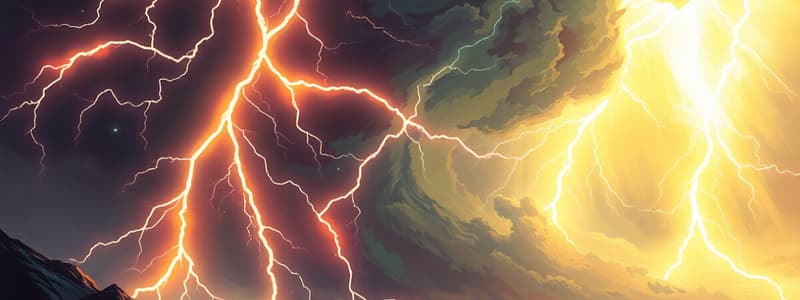Podcast
Questions and Answers
Lightning can cause damage to property.
Lightning can cause damage to property.
True (A)
Lightning is a minor cause of wildfires.
Lightning is a minor cause of wildfires.
False (B)
Lightning rods are designed to attract lightning to a specific point.
Lightning rods are designed to attract lightning to a specific point.
True (A)
Surge protectors safeguard electronic devices from power reductions.
Surge protectors safeguard electronic devices from power reductions.
Thunder is caused by the rapid cooling of air around a lightning channel.
Thunder is caused by the rapid cooling of air around a lightning channel.
The speed of sound is faster than the speed of light.
The speed of sound is faster than the speed of light.
Lightning is a sudden electrostatic discharge.
Lightning is a sudden electrostatic discharge.
Lightning requires a potential difference of only hundreds of volts to occur.
Lightning requires a potential difference of only hundreds of volts to occur.
Supercell thunderstorms are small and short-lived.
Supercell thunderstorms are small and short-lived.
Thunderstorms are least common in warm, humid regions.
Thunderstorms are least common in warm, humid regions.
Charge separation in thunderclouds is fully understood.
Charge separation in thunderclouds is fully understood.
Lighter, negatively charged particles sink to the lower part of the cloud.
Lighter, negatively charged particles sink to the lower part of the cloud.
Cloud-to-ground lightning is the least dangerous type of lightning.
Cloud-to-ground lightning is the least dangerous type of lightning.
Cloud-to-cloud lightning occurs inside the same cloud.
Cloud-to-cloud lightning occurs inside the same cloud.
The stepped leader is a channel of positively charged air.
The stepped leader is a channel of positively charged air.
Lightning strikes pose no risk of starting fires.
Lightning strikes pose no risk of starting fires.
Flashcards
What is Lightning?
What is Lightning?
A sudden, massive electrostatic discharge between charged regions.
Voltage for lightning
Voltage for lightning
Millions or billions of volts.
Cause of Charge Separation
Cause of Charge Separation
Collisions between ice crystals, graupel, and supercooled water droplets.
Types of Lightning
Types of Lightning
Signup and view all the flashcards
Stepped Leader
Stepped Leader
Signup and view all the flashcards
Streamer
Streamer
Signup and view all the flashcards
Return Stroke
Return Stroke
Signup and view all the flashcards
Lightning Temperature
Lightning Temperature
Signup and view all the flashcards
Lightning's Property Impact
Lightning's Property Impact
Signup and view all the flashcards
Lightning-Caused Wildfires
Lightning-Caused Wildfires
Signup and view all the flashcards
Lightning Rod
Lightning Rod
Signup and view all the flashcards
Surge Protectors
Surge Protectors
Signup and view all the flashcards
Thunder
Thunder
Signup and view all the flashcards
Cause of Thunder
Cause of Thunder
Signup and view all the flashcards
Single-Cell Thunderstorms
Single-Cell Thunderstorms
Signup and view all the flashcards
Supercell Thunderstorms
Supercell Thunderstorms
Signup and view all the flashcards
Study Notes
- Lightning and thunder are dramatic displays of atmospheric electricity, closely related phenomena occurring during thunderstorms.
Lightning
- Lightning refers to a sudden, massive electrostatic discharge between electrically charged regions within clouds, between clouds, or between a cloud and the ground.
- Lightning requires an immense potential difference, typically millions or billions of volts.
- Its high voltage overcomes air's insulating properties.
- Charge separation within a thundercloud involves collisions between ice crystals, graupel (soft hail), and supercooled water droplets.
- Heavier, negatively charged particles sink to the lower part of the cloud, and lighter, positively charged particles rise to the upper part.
- This intensifies the electric field as more charge accumulates.
- When the electric field becomes strong enough, it overcomes the air's resistance, and a lightning discharge occurs.
- Lightning includes:
- Cloud-to-ground (CG) lightning: Striking Earth's surface and the most dangerous.
- Cloud-to-cloud (CC) or intracloud (IC) lightning: Occurring between different clouds or within the same cloud.
- Cloud-to-air (CA) lightning: Discharging from a cloud into the surrounding air.
- Cloud-to-ground lightning typically begins with a stepped leader, a negatively charged air channel that zigzags downward from the cloud.
- Positively charged streamers rise from objects like trees, buildings, and people as the stepped leader approaches the ground.
- A continuous channel forms when a streamer connects with the stepped leader, and a return stroke of intense current surges upward.
- The return stroke produces the bright flash that is seen.
- A single lightning flash may consist of multiple strokes, following the same channel in rapid succession.
- A lightning channel can reach up to 30,000 degrees Celsius (54,000 degrees Fahrenheit).
- Lightning strikes involve:
- Electrocution.
- Fires.
- Power outages.
- Damage to property.
- Wildfires.
- Lightning protection measures include:
- Lightning rods.
- Surge protectors.
- Awareness and precautions.
Thunder
- Thunder comes from the rapid heating of air around a lightning channel.
- The extreme heat causes the air to expand explosively, creating a shock wave that propagates outward as a sound wave.
- Thunder can range from a sharp crack to a low rumble.
- Sound is much slower than light.
- Seeing lightning before hearing thunder occurs due to the difference in speed of sound and light.
- The time interval between lightning and thunder can be used to estimate the distance to the lightning strike.
- Every 3 seconds between the flash and the sound approximates 1 kilometer (or every 5 seconds to 1 mile).
- Thunderstorms include:
- Single-cell thunderstorms.
- Multicell thunderstorms.
- Supercell thunderstorms.
- Thunderstorms are most common in warm, humid regions where there is ample moisture and instability in the atmosphere.
- Thunderstorms typically occur during the afternoon and evening.
- Meteorology helps scientists understand and predict thunderstorms and their associated hazards.
Studying That Suits You
Use AI to generate personalized quizzes and flashcards to suit your learning preferences.




